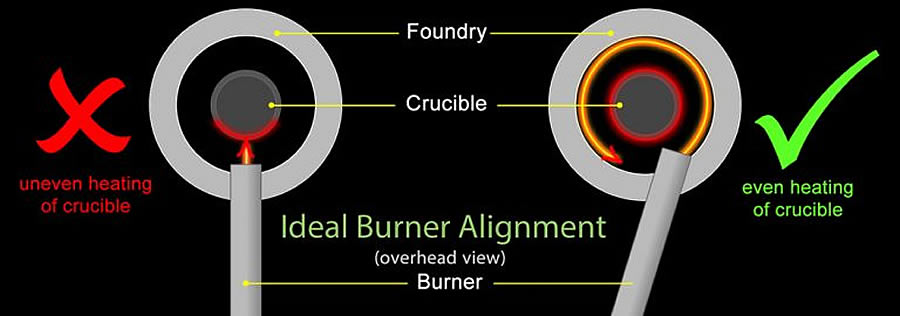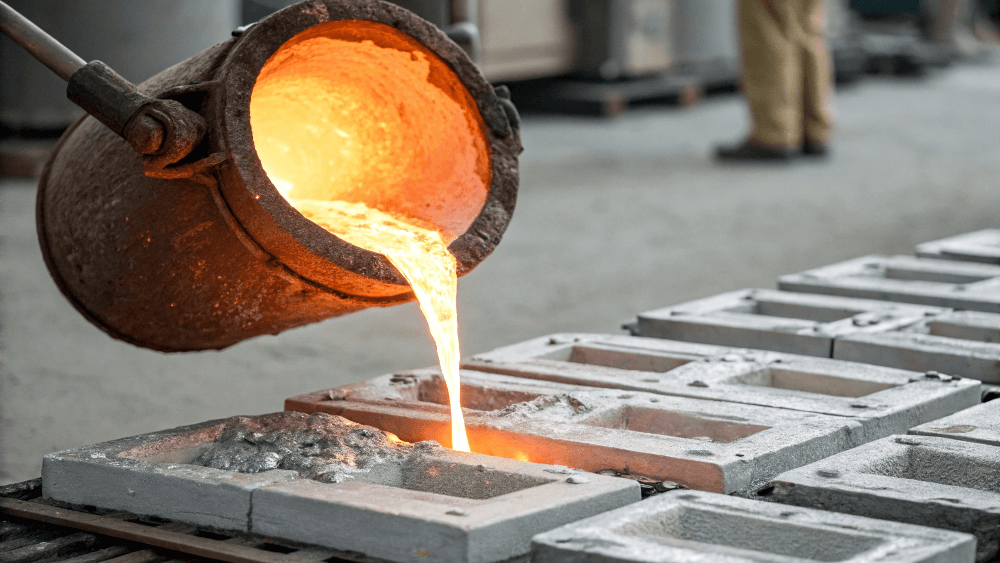How Aluminum Foundry Contributes to Improvements in Aerospace Engineering
Aluminum shops are integral to innovations in aerospace design. They produce light-weight, high-strength parts that are essential for modern airplane. Through innovative casting methods, these factories develop complicated geometries that boost architectural integrity. Furthermore, the development of superior Aluminum alloys supports the sector's concentrate on gas effectiveness and sustainability. Difficulties remain in the production procedure. Understanding these variables reveals the extensive influence of Aluminum on aviation's future.
The Relevance of Lightweight Products in Aerospace Design
As the aerospace market proceeds to develop, the relevance of lightweight products becomes increasingly evident. The need for effectiveness and sustainability drives engineers to prioritize making use of products that minimize overall weight without compromising structural integrity. Light-weight products, especially Aluminum, play an important duty in enhancing gas efficiency, boosting payload ability, and enhancing the general performance of airplane.
The assimilation of these materials enables for cutting-edge layouts, allowing suppliers to produce even more aerodynamic forms that can stand up to extreme problems. The decrease in weight not only reduces operational expenses yet also adds to a decreased ecological footprint, lining up with worldwide efforts toward sustainability in air travel.
Advanced Casting Techniques in Aluminum Foundries
Advanced casting techniques in Aluminum shops play a critical function in aerospace design by enabling the production of specific and lightweight parts. Innovations in mold and mildew style and precision casting processes are important in achieving excellent efficiency and structural stability. Furthermore, the advancement of lightweight alloys improves the overall effectiveness and efficiency of aerospace applications.
Cutting-edge Mold And Mildew Style
Ingenious mold and mildew style plays an important role in the effectiveness and effectiveness of Aluminum shops, particularly within the aerospace industry. By leveraging innovative products and strategies, modern molds can be engineered to endure heats and pressures, ensuring peak performance during the spreading process. These designs often incorporate complicated geometries that permit the manufacturing of lightweight yet structurally sound components, important for aerospace applications. Furthermore, the usage of computer-aided layout (CAD) software program facilitates specific modeling, allowing factories to simulate and refine mold designs prior to physical production begins. This not only enhances the top quality of cast components yet also decreases waste and preparation, leading to significant cost financial savings. Generally, innovative mold and mildew style is a keystone of progression in Aluminum Foundry innovation for aerospace design.
Precision Casting Procedures
The efficiency of ingenious mold layouts seamlessly incorporates with precision spreading processes, which are important for generating top quality Aluminum parts in aerospace design. These procedures, consisting of sand casting, pass away casting, and investment casting, assure the production of intricate geometries with limited resistances. Advanced strategies like vacuum spreading and stress die casting enhance the honesty and surface area coating of the end products. Accuracy casting decreases product waste while making the most of the mechanical buildings of Aluminum, vital for aerospace applications. Furthermore, employing real-time monitoring and progressed simulation tools throughout the spreading process enables instant changes, bring about enhanced quality control. Collectively, these accuracy spreading processes placement Aluminum shops at the forefront of aerospace development, sustaining the industry's need for integrity and efficiency.
Lightweight Alloy Growth
As aerospace designers look for to improve fuel performance and efficiency, light-weight alloy advancement comes to be a crucial emphasis in Aluminum factories. These shops use innovative spreading methods to create alloys that offer exceptional strength-to-weight proportions. Advancements in alloy composition, including the consolidation of elements like lithium and magnesium, make it possible for the manufacturing of products that hold up against severe problems while reducing total aircraft weight. Strategies such as die spreading and financial investment casting promote the precision manufacturing of complicated shapes, which are important for aerospace applications. Furthermore, ongoing research intends to optimize these alloys for enhanced mechanical homes and enhanced resilience. By prioritizing light-weight alloy development, Aluminum factories considerably contribute to the development of aerospace engineering, leading the way for much more lasting and reliable aircraft styles.

Enhancing Architectural Stability Through Aluminum Components
Aluminum components use significant advantages in enhancing architectural honesty within aerospace engineering. Their lightweight nature adds to overall performance while maintaining stamina, which is necessary for aircraft performance. Furthermore, the stress resistance buildings of Aluminum aid assure the resilience and integrity of aerospace frameworks under different operational problems.
Light-weight Product Advantages
While traditional materials commonly compromise weight for stamina, making use of Aluminum elements in aerospace engineering uses significant benefits in structural integrity. Aluminum's light-weight nature adds to overall layout efficiency, permitting even more streamlined airplane that eat less fuel, consequently improving sustainability. The product's excellent strength-to-weight ratio guarantees that parts preserve longevity without adding unnecessary mass. This top quality cultivates improved efficiency and agility in flight, as well as optimized haul capacities. Additionally, Aluminum's resistance to deterioration lengthens the lifespan of aerospace structures, lowering maintenance expenses and enhancing security. As manufacturers significantly take on Aluminum alloys, the aerospace industry experiences a transformative shift towards extra reliable and reliable engineering solutions that focus on both efficiency and ecological obligation.
Anxiety Resistance Qualities
Although different materials possess unique residential properties, Aluminum's extraordinary tension resistance stands out as an essential aspect in enhancing the architectural integrity of aerospace elements. This resistance plays an essential role in guaranteeing that aircraft can hold up against numerous functional anxieties, consisting of exhaustion, influence, and ecological conditions. Aluminum alloys, specifically engineered for aerospace applications, show high tensile toughness while maintaining light-weight attributes, allowing engineers to create extra effective frameworks - Aluminum Foundry. In addition, the capacity of Aluminum to endure cyclic loading without substantial contortion adds to the durability and dependability of aerospace elements. As developments proceed in Aluminum Foundry strategies, the development of stress-resistant Aluminum elements guarantees additional enhancements in performance, safety and security, and performance across the aerospace sector, solidifying Aluminum's role as a preferred material in contemporary design
Gas Performance Improvements Driven by Aluminum Innovations
As the aerospace industry seeks to improve gas efficiency, innovative usages of Aluminum have actually become a crucial solution. Aluminum's lightweight nature notably minimizes aircraft weight, permitting lower fuel intake during flight. This reduction in weight is essential, as even small decreases can cause significant renovations in total gas economic situation.
Advanced Aluminum alloys, developed for enhanced toughness and durability, make it possible for manufacturers to create elements that maintain architectural integrity while lessening mass - Aluminum Foundry. Furthermore, the integration of Aluminum in airframes and engine components helps with boosted aerodynamics, adding to minimized drag and raised performance
The adoption of Aluminum in aerospace not just fulfills the demand for fuel-efficient layout yet additionally aligns with governing stress for lower exhausts. As these developments proceed to evolve, they play a considerable function in setting brand-new benchmarks for fuel performance, making certain that the aerospace market can meet growing economic and ecological obstacles.

The Duty of Aluminum in Sustainable Aviation Practices
The enhancing focus on lasting aviation methods has positioned Aluminum as a crucial material in the mission for greener aircraft style. Recognized for its lightweight residential properties, Aluminum considerably lowers airplane weight, resulting in reduced fuel intake and exhausts. Its recyclability additionally enhances its sustainability profile, as Aluminum can be reused forever without loss of quality. This particular sustains a circular economic situation within the air travel industry, minimizing waste and source exhaustion.
Innovations in Aluminum alloys have actually improved their stamina and deterioration resistance, permitting for longer solution life and lowered upkeep requirements. These developments facilitate the advancement of much more effective airplane frameworks, contributing to overall sustainability Check This Out initiatives. Furthermore, Aluminum's thermal conductivity plays a crucial function in energy-efficient styles, enhancing systems such as heat exchangers. Jointly, these characteristics underscore Aluminum's pivotal role in advancing lasting aeronautics, straightening with worldwide initiatives focused on reducing the ecological impact of air traveling.
Difficulties Encountered by Aluminum Foundries in Aerospace Production
While Aluminum factories play an essential role in aerospace manufacturing, they encounter significant obstacles that can influence manufacturing effectiveness and high quality. One significant challenge is the rigid quality assurance standards required in the aerospace market. Any type of issue can endanger security and performance, demanding strenuous assessment processes that expand manufacturing timelines. Additionally, foundries commonly emulate fluctuating basic material costs, which can affect prices and success. The intricacy of Aluminum alloys used in aerospace applications further makes complex the production process, as precise formulations are get more vital for accomplishing desired mechanical buildings. In addition, proficient labor lacks impede the capability to maintain high-grade production levels. Environmental policies enforce limitations on discharges and waste management, calling for factories to spend in lasting techniques, which can be cost-prohibitive. These elements jointly create a landscape where Aluminum foundries should constantly adjust to fulfill the evolving demands of aerospace production while guaranteeing security and conformity.
Future Patterns in Aluminum Applications for Aerospace Engineering
With developments in innovation and increasing needs for efficiency, the future of Aluminum applications in aerospace engineering is positioned for considerable transformation. The combination of innovative Aluminum alloys and compounds is expected to boost strength-to-weight ratios, leading to even more fuel-efficient aircraft layouts. Additionally, improvements in additive manufacturing techniques will certainly permit the production of complicated Aluminum frameworks that were previously difficult, maximizing performance and reducing waste.

Lasting practices will play a necessary function, with an expanding focus on reusing Aluminum to reduce ecological influence. The aerospace field is likely to accept smarter manufacturing processes, such as automation and man-made knowledge, making certain better and accuracy in Aluminum components. Additionally, partnerships in between Aluminum foundries and aerospace companies will foster research study and development, paving the method for new applications that satisfy the strict demands of contemporary aerospace engineering - Aluminum Foundry. In general, the future looks promising for Aluminum's duty fit the skies
Regularly Asked Concerns
What Are the Ecological Impacts of Aluminum Production in Aerospace?
The ecological effects of Aluminum production in aerospace consist of significant power intake, greenhouse gas discharges, and environment disturbance. Furthermore, mining processes can lead to soil destruction Recommended Reading and water contamination, raising problems regarding sustainability and environmental equilibrium.
Exactly How Does Aluminum Contrast to Various Other Materials in Aerospace Applications?
Aluminum provides a distinct combination of lightweight buildings, deterioration resistance, and cost-effectiveness compared to various other materials. Its high strength-to-weight proportion makes it especially beneficial for aerospace applications, boosting gas efficiency and total efficiency in airplane design.
What Credentials Do Aluminum Foundry Workers Need for Aerospace Projects?
Aluminum Foundry workers require specific training in metallurgy and casting strategies, along with expertise of aerospace market standards. Certifications in quality assurance and safety methods are also necessary to ensure compliance with strict aerospace project requirements.
Exist Any Type Of Security Worry About Using Aluminum in Aerospace Engineering?
Security worries pertaining to Aluminum in aerospace engineering consist of sensitivity to fatigue, stress, and corrosion cracks. Correct therapy and alloy choice are vital to mitigate these dangers, making sure architectural stability and overall security in aerospace applications.
Just How Does Aluminum Recycling Advantage the Aerospace Industry?
Aluminum recycling considerably profits the aerospace industry by minimizing product costs, decreasing ecological influence, and preserving power. This sustainable method enhances the industry's efficiency while advertising using lightweight, high-performance elements in aircraft manufacturing.
Advanced spreading strategies in Aluminum shops play an important function in aerospace design by enabling the production of exact and lightweight components. Innovative mold and mildew layout plays a necessary function in the effectiveness and effectiveness of Aluminum shops, particularly within the aerospace field. As aerospace designers seek to boost gas effectiveness and performance, light-weight alloy development comes to be an essential emphasis in Aluminum foundries. Aluminum alloys, specifically crafted for aerospace applications, display high tensile strength while keeping light-weight attributes, making it possible for engineers to design much more efficient structures. Partnerships between Aluminum shops and aerospace business will cultivate research study and growth, paving the way for brand-new applications that fulfill the rigid demands of modern-day aerospace design.